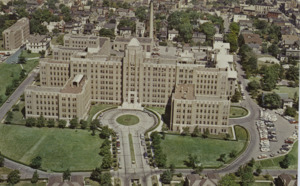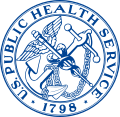United States Public Health Service facts for kids

Logo of the United States
Public Health Service |
|
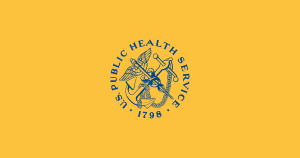 Flag of the U.S. Public Health Service |
|
| Agency overview | |
|---|---|
| Formed | 1798 (reorganized/renamed: 1871/1902/1912) |
| Jurisdiction | Federal government of the United States |
| Headquarters | Hubert H. Humphrey Building Washington, D.C. |
| Agency executive |
|
| Parent agency | Department of Health and Human Services |
| Website | https://www.hhs.gov/ash |
| "Public Health Service March" | |
The United States Public Health Service (USPHS or PHS) is a group of agencies that work to protect and improve the health of people in the United States. It is part of the Department of Health and Human Services (HHS). The USPHS includes eight of the eleven main divisions within HHS. The Assistant Secretary for Health helps lead the USPHS.
A special part of the USPHS is the Public Health Service Commissioned Corps (PHSCC). This is a team of uniformed health professionals. It is one of the eight uniformed services of the United States that serve the country. The USPHS started way back in 1798. It began as a system of hospitals for sailors. Over time, it grew to include more health services and research. In 1912, it was officially named the Public Health Service.
Contents
What the USPHS Does
The USPHS is made up of several important agencies. These agencies work on different parts of public health. They are all part of the Department of Health and Human Services (HHS).
Here are some of the main agencies in the USPHS:
- National Institutes of Health (NIH): This group does a lot of medical research. They work to find cures and better treatments for diseases.
- Centers for Disease Control and Prevention (CDC): The CDC helps stop the spread of diseases. They also teach people how to stay healthy.
- Indian Health Service (IHS): This service provides healthcare to Native American and Alaska Native people.
- Food and Drug Administration (FDA): The FDA makes sure our food, medicines, and medical devices are safe.
- Agency for Toxic Substances and Disease Registry (ATSDR): This agency helps protect people from harmful chemicals.
- Health Resources and Services Administration (HRSA): HRSA works to improve healthcare for people who live in rural areas or don't have easy access to doctors.
- Agency for Healthcare Research and Quality (AHRQ): AHRQ does research to make healthcare safer and better for everyone.
- Substance Abuse and Mental Health Services Administration (SAMHSA): SAMHSA helps people dealing with substance abuse and mental health issues.
There are also three special offices that are part of the USPHS. These include the Office of the Assistant Secretary for Health, the Office of the Assistant Secretary for Preparedness and Response, and the Office of Global Affairs.
The Public Health Service Commissioned Corps
The United States Public Health Service Commissioned Corps (PHSCC) is a team of over 6,000 health experts. They wear uniforms, just like people in the military. Their job is to promote health and prevent diseases. These officers often work on the front lines. They help fight against sickness and poor health conditions.
The main goal of the PHSCC is to protect and improve the health and safety of people in the United States. They do this by:
- Responding quickly to health emergencies.
- Being leaders in public health practices.
- Advancing public health science through research.
The PHSCC is one of the eight uniformed services in the U.S. government. Its officers come from many different health fields. These include doctors, nurses, dentists, pharmacists, engineers, and scientists. They work in various government agencies and programs.
PHSCC officers wear uniforms that look like those of the United States Navy. They have special PHSCC badges. They also use the same ranks as the U.S. Navy, from ensign to admiral. Their service is considered military service for retirement and some other benefits.
History of the USPHS
Modern public health started to grow in the 1800s. This was when scientists began to understand how diseases spread. As people learned more about contagious diseases, they found ways to control them. It became clear that everyone needed to work together to stop diseases. So, new groups and agencies were created to help.
Early Days: Marine Hospital Service
The USPHS began in 1798. At that time, President John Adams helped create hospitals for sick sailors. These hospitals were first built along the East Coast. As the U.S. grew, more marine hospitals were added. This system was called the Marine Hospital Service. It was part of the Department of the Treasury.
In 1871, the scattered hospitals became one organized system. It was still called the Marine Hospital Service. Its main office was in Washington, D.C.. A leader called the Supervising Surgeon was put in charge. Later, this job was renamed the Surgeon General. John Maynard Woodworth was the first Surgeon General. He made big changes. He had doctors wear uniforms and take exams. This created a team of skilled doctors who could be sent where they were needed. In 1889, this team officially became the commissioned officer corps.
The Marine Hospital Service started doing more than just caring for sailors. It began to control infectious diseases. It also collected health information and did scientific research. In 1878, it gained the power to enforce quarantines. This meant they could stop sick people from entering the country. They also checked immigrants arriving at places like Ellis Island. In 1887, a small lab was started for studying bacteria. This lab later grew into the National Institutes of Health.
Becoming the Public Health Service
Because the Service was doing so much more, its name changed in 1902. It became the Public Health and Marine Hospital Service. Then, in 1912, its name changed again to simply the Public Health Service (PHS). This showed that its main focus was now on the health of all people.
The 1912 law also expanded the PHS's work to include non-communicable diseases. These are diseases that don't spread from person to person. The PHS also started researching water pollution in 1913. This work eventually led to the creation of the Environmental Protection Agency. In 1914, they began studying health in workplaces. This led to the National Institute for Occupational Safety and Health.
In 1930, the small lab that started in 1887 became the National Institutes of Health (NIH). It moved to a new campus in Bethesda, Maryland in 1938. In 1939, the PHS moved to a new government agency. In 1942, a group was created to control malaria. This group later became the Centers for Disease Control and Prevention (CDC) in 1946.
During the 1920s and 1930s, many marine hospitals were rebuilt into larger, more impressive buildings. In 1933, the new Public Health Service Building opened in Washington, D.C.
Mid-20th Century Changes
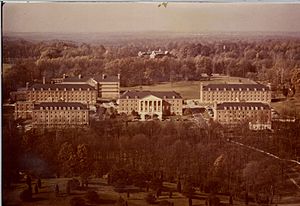
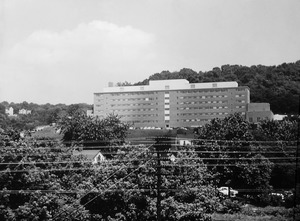
By 1943, the PHS had many different divisions. To make things simpler, these divisions were grouped into three main parts. These were the Bureau of State Services, the Bureau of Medical Services, and the National Institute of Health. Also, in 1944, all the laws about public health were put together into one main law. This was called the Public Health Service Act of 1944.
The mid-1900s was a time of growth for NIH and environmental health programs. NIH grew to include many new institutes. Environmental health programs expanded to study air, industrial, and chemical pollution. However, many of the original marine hospitals began to close during this time.
In 1953, the PHS became part of the new Department of Health, Education and Welfare. In 1955, the Indian Health Service was created. It took over healthcare for Native American people.
Modern Era of Public Health
Between 1966 and 1973, the PHS went through more big changes. The old structure was replaced with new agencies. The position of Assistant Secretary for Health was created in 1968. This person became the top leader of the PHS. Also in 1968, the Food and Drug Administration (FDA) became part of the PHS. The goal of these changes was to help different health groups work together better.
During this time, more hospitals closed. Many of the environmental health programs moved out of PHS to form the new Environmental Protection Agency (EPA) in 1970. The National Institute for Occupational Safety and Health was also created around this time.
Since 1973, the PHS has included six to eight main agencies. These include NIH, FDA, and CDC. Other changes have happened over the years:
- The Agency for Toxic Substances and Disease Registry was created in 1980.
- The Health Resources and Services Administration (HRSA) was formed in 1982.
- The Indian Health Service became its own agency in 1988.
- The Agency for Healthcare Research and Quality was created in 1989.
- The Substance Abuse and Mental Health Services Administration was formed in 1992.
The PHS hospital system was finally closed in 1981. The last eight hospitals were given to other groups. In 1980, the Department of Health, Education and Welfare was renamed the Department of Health and Human Services. In 1995, the PHS agencies began reporting directly to the Secretary of Health and Human Services. This meant the PHS was no longer a separate administrative level, but its agencies still work together for public health.
Important Work of the USPHS
Many people have done important work through the Public Health Service. For example, Dr. Sara Josephine Baker helped poor families in New York City keep their babies healthy. She sent nurses into crowded areas to teach mothers about caring for their infants. Another important person was Lillian Wald. She started a settlement house in New York that brought healthcare to people in need.
The PHS has also played a big role in protecting our environment. In 1969, a PHS survey looked at over a thousand drinking water systems. It found that water quality was a concern, especially in smaller systems. This survey helped lead to the Safe Drinking Water Act in 1974. This law set standards to make sure our drinking water is safe.
The Clean Air Act of 1963 gave the PHS power to act against industries that were polluting the air. They could step in if pollution crossed state lines. The PHS also started keeping track of air pollution levels. These actions helped make our air cleaner.
Images for kids


